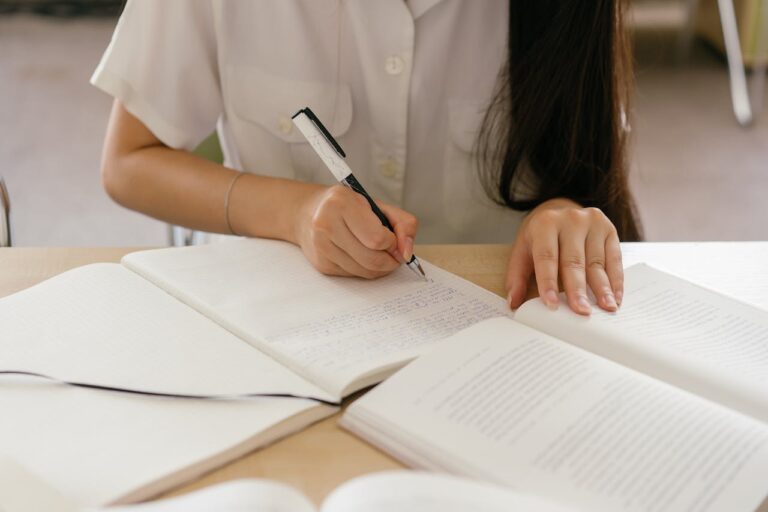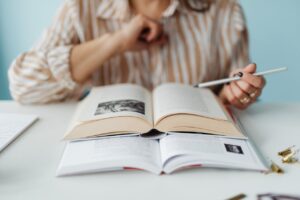Plagiarism is a grave academic mistake, and many students accidentally do it, which can lead to losing many points. As an experienced tutor, I’ve noticed that students have difficulty being original in their papers, especially when dealing with difficult-to-understand topics. If you follow the right tactics, you can forget about plagiarism.
In this piece, I’ll show you how to avoid plagiarism in an essay, discuss common errors, and offer easy tips to keep your work original.
What Is Plagiarism in Academic Writing?
In my view, one important part of writing essays that is often ignored is really knowing what plagiarism is. Many students think plagiarism only happens when they copy a full paper, but that’s false. Plagiarism means using someone else’s words, ideas, or way of organizing information without giving credit. If you take a line or change a few words without giving credit, it can still be seen as plagiarism.
From what I’ve seen, students usually fight with plagiarism not because they want to cheat but because they don’t clearly understand what counts as original work. Some people believe that all it takes to make something their own is to change a few words from the original source. Some people think they’re safe if they don’t copy complete lines. However, essay grading criteria are generally stringent, and teachers spot any misuse of sources.
For example, according to basic IB rules, plagiarism is a major issue. Taking small parts of someone else’s work without giving them credit can still be seen as cheating in school. In IB assignments, being original means more than just trying to avoid low scores; it also means showing that you can think critically, do your study, and maintain your honor.
Common Types of Plagiarism
In my opinion, many IB students don’t understand that there are different kinds of plagiarism. Some of the most popular examples are:
- Direct plagiarism is copying text exactly as it is without crediting the source. It is the easiest type of plagiarism to spot, and teachers often notice it immediately.
- Self-plagiarism means using your own previous work for a new task. Many students think it’s okay to use it again because they wrote it, but IB rules say each job must be unique.
- Paraphrasing plagiarism means replacing some words but still following the same sentence structure as the original text. Changing the words a bit but keeping the same sentence structure and meaning without crediting the source is still considered plagiarism.
- Mosaic plagiarism occurs when you combine your own words with sentences you borrowed from someone else without crediting them. It is one of the hardest kinds of cheating to spot, but it is still considered dishonest in school.
- Incremental plagiarism definition – using small parts of someone else’s work without giving them credit. Even if you use only a line or two, you still need to give credit to the original source.
Many students don’t plagiarize on purpose, but not knowing the rules can still result in credit loss. If you’re not sure you’ve mentioned a source correctly, take the time to check again. It’s better to take a few extra minutes to check sources than to face charges of plagiarism.

What Is a Good Rule to Follow to Avoid Plagiarism?
In my experience, many students don’t intend to plagiarize. They just don’t understand how to use sources properly in their work. That’s why you must know how to cite, paraphrase, and quote sources properly.
Cite Your Sources
Proper reference is one of the most potent methods to avoid plagiarism. Many students think they only need to cite sources when they use straight quotes, but that’s incorrect. If you use someone else’s idea, even if you put it in your own words, you still need to give them credit.
If you’re unsure how to cite sources, I suggest using quotation tools or reference books from your school. Many free online tools can help you create notes in the right style, making them more manageable. Make sure to include sources and a reference in the text as well. Students often forget that it’s not enough to list sources at the end of an essay. You must also mention them in the text when referring to an idea, figure, or quote.
Related Articles:
- What Tools and Techniques Can You Use to Avoid Plagiarism in the EE?
- What Steps Should You Take If Plagiarism Strikes Your Extended Essay?
- How Can You Ensure Originality in Your IB Extended Essay?
- How to Write IB Extended Essay
- Pros and Pitfalls of Using Internet-Sourced EE Topics
- Can You Ask Questions in an Essay?
Paraphrase Correctly
Many students think that changing just a few words is enough to avoid plagiarism. But that’s not correct. Good paraphrasing is when you rewrite information using your own words and sentences but keep the same meaning.
A good rule is to read the information, set it away, and then write down what you remember in your own words before looking back at the original source. This way, you’re not just changing the words of the original text but genuinely understanding and presenting it in a new way.
In addition, even if you accurately quote, you still need to credit the original author. Many students believe that quoting doesn’t require a reference, but this is a common mistake. The information still belongs to someone else, and not giving thanks can accidentally lead to plagiarism.
Use Quotation Marks
Sometimes, you must use an author’s exact words to support your point. Always use quotation marks for straight quotes, and give proper credit to the source. If you don’t do this, your work could be marked for plagiarism, even if you only used a brief line.
In my opinion, IB students often use too many straight quotes in their essays. Quoting can be helpful, but depending too much on others’ words weakens your analysis. A good rule is to use direct quotes only when the wording is especially powerful or challenging to rephrase.
If you’re talking about an important definition, a famous quote, or a strong case, it’s best to use a quote. For general information, it’s often better to rephrase the content.
In short, always consider how to use sources in your work. The goal is to use the study to back up your ideas, not to take their place. When done right, sources, paraphrasing, and quotes can help you write good, original essays while following academic honesty rules.
How to Copy an Essay Without Plagiarizing?
Many students wonder, “How can I copy an essay without plagiarizing?” Truthfully, you cannot do it. The one correct answer to this question is that you must do better research. Instead of copying, look at different sources, compare various points of view, and incorporate the ideas into your essay from your standpoint.
By the way, AI can help with writing, but using it too much can cause problems with plagiarism. Plagiarism checks help ensure creativity, but AI paraphrasing tools can still create content that gets flagged. When using them, always check and change the text to ensure it matches your ideas.
Crush your IB goals with our extended essay writing service!
Leave the stress to our expert writers and enjoy some downtime. Excellence is just a click away.

How to Plagiarize Without Plagiarizing?
Some students try to find ways to plagiarize without actually plagiarizing, hoping to find gaps in the rules. However, there are no quick fixes. Teachers use plagiarism detection tools like Turnitin, which can spot even small amounts of copied text.
Instead of finding ways to get around plagiarism, it’s better to focus on building good writing habits. Take time to review your study, create your material, and always give credit to your sources.
How to Get Around Plagiarism the Right Way?
Organize your study from the beginning to avoid plagiarism. Instead of copying and putting information into your notes, write down key points in your own words. Make sure to separate straight quotes, reworded ideas, and your thoughts. It helps avoid the usual error of losing the source of an idea, which can lead to plagiarism. Also, follow these easy steps:
- Write down clear notes. Keep direct quotes and paraphrased content apart.
- Make sure to add sources correctly while writing. Don’t leave them until the last minute.
- Create a plan. This plan allows you to come up with your ideas rather than copying those of others.
- Check your sources closely. Make sure to give credit for any ideas you use that aren’t your own.
Another important factor is managing your time well. Rushed writing often leads to plagiarism because students feel desperate and copy others’ work. Begin early and break the work into steps: researching, writing, and revising.
Before you hand in your essay, use plagiarism detection tools. But don’t depend on these tools too much—sometimes, they mistake common words for errors and other times, they might miss copied parts. Use them as an added security measure, but ensure your writing is original from the beginning.
Final Thoughts
Avoiding plagiarism is about building honesty in education. I believe that original writing comes from knowing the topic well, sharing your thoughts, and properly citing your sources.
Focus on developing your writing abilities rather than researching how to get around plagiarism. Use these tactics, handle your time effectively, and be proud of creating work that is uniquely yours. I can tell you that being original will help you in school and your future career.
And if you’re feeling stressed with your IB homework, BuyExtendedEssay.com is here to help.

Valerie Green
Valerie Green is a dedicated educator who spends her time helping high school and college students succeed. She writes articles and guides for various online education projects, providing students with the tools they need to excel in their studies. Friendly and approachable, she is committed to making a difference in the lives of students.

Can You Ask Questions in an Essay?
Let’s get this out of the way immediately: can you ask questions in an essay? Yes—you absolutely can. And sometimes, you should. That said, they need to be used correctly, at the right moment, and with the right purpose.

Can Turnitin Detect Essays Bought Online?
Many students wonder: Can Turnitin detect essays bought online? The answer isn’t as simple. Turnitin does not verify authorship, but it is highly effective at detecting text similarities.

How to Avoid Plagiarism in Your Essay?
Plagiarism is a serious issue in academic writing, but avoiding it is easier than you think. In this guide, I’ll share practical IB writing tips to help you cite sources correctly, paraphrase effectively, and develop strong research habits.

What Are Interdisciplinary Topics in IB Extended Essays?
This article explains what interdisciplinary IB Extended Essays are, why they matter, and how to select the best topic. You’ll also find topic ideas and research strategies.

How to Write an Environmental Systems and Societies Extended Essay?
This guide covers everything from selecting a compelling topic to organizing your essay effectively. Learn how to balance scientific and societal perspectives, apply IB’s assessment criteria, and use expert tips to maximize your score.

How to Write a Theatre Studies Extended Essay?
In my experience, the best IB Theatre Studies Extended Essays are those that go beyond simple description—strong essays critically examine performances, directorial choices, or theoretical perspectives with depth and precision.

